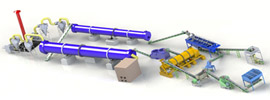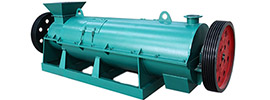The fertilizer rotary drum granulator (also known as a drum granulator) is a key piece of equipment that utilizes physical rotation and chemical bonding to transform powdery materials into granules. It is widely applied in the production of organic fertilizers, compound fertilizers, and other agricultural inputs. Below are its operating principles and core advantages:
I. Working Principle
-
Rotational Motion
The material rolls and tumbles inside an inclined rotating drum due to the combined effects of centrifugal force, gravity, and friction. The drum’s inclination angle (typically 2°–10°) can be adjusted to control material retention time.
-
Agglomeration Granulation
Powdery materials gradually bond into small particles under moist conditions (achieved via a spray system adding water or binders such as molasses or clay). These particles continuously grow and compact through rolling collisions, forming spherical granules.
-
Drying/Curing
Some granulators incorporate hot-air systems to evaporate moisture and strengthen particle integrity during granulation. This process raises material temperature, resulting in lower moisture content in the final granules and improved drying efficiency.
-
Particle Classification and Post-Processing
Larger granules exit the drum via gravity, while fine powders are recycled for re-granulation. The granules undergo drying, cooling, and screening to produce uniform finished products.
II. Core Advantages
-
High Granulation Efficiency and Resource Utilization
Granulation rates can reach 70%, with minimal waste. Even recycled fines have small particle sizes, facilitating easy reprocessing.
-
Durable Particles with High Crush Resistance
Rolling compaction produces dense granules that resist abrasion and corrosion, making them suitable for long-distance transportation and prolonged storage.
-
Flexible Adjustability for Diverse Needs
Parameters such as rotational speed (5–20 rpm), inclination angle, and moisture content can be adjusted to control particle size (typically 2–8 mm), meeting specifications for various fertilizer products.
-
Continuous Production and High Automation
Ideal for large-scale processing, the system offers high efficiency, simple operation, and low maintenance requirements.
-
Broad Material Compatibility
Effective for viscous organic materials (e.g., livestock manure, food waste, straw powder) with minimal particle size requirements. It also supports the addition of humic acid, microbial agents, and other additives to enhance fertilizer quality.
-
Energy Efficiency and Environmental Benefits
Steam injection raises material temperature, reducing post-granulation drying energy consumption. Wear-resistant linings (e.g., rubber plates or acid-resistant stainless steel) enable automatic scar removal, streamlining operations.
III. Applications
- Agriculture: Produces organic fertilizers to improve soil fertility and structure.
- Livestock Industry: Treats animal waste, mitigating environmental pollution through resource recycling.
- Environmental Protection: Processes organic waste from municipal solid waste, reducing landfill volumes.
- Industrial Sector: Handles organic byproducts from food and beverage industries, enhancing resource utilization.
IV. Technical Specifications (Example)
| Specification (mm) |
Production Capacity (t/h) |
Main Motor Power (kW) |
Inclination Angle (°) |
| Φ1800 |
3 |
5.5 |
45 |
| Φ2200 |
8 |
7.5 |
35–55 |
| Φ2500 |
10 |
11 |
35–55 |
V. Development Trends
Advancements in technology are driving rotary drum granulators toward automation and sustainability. For instance, intelligent control systems optimize process parameters to further reduce energy consumption, while novel wear-resistant materials extend equipment lifespan and lower maintenance costs.
This translation maintains technical precision while ensuring clarity for an international audience in the agricultural and industrial sectors.
 Send us a Email
Send us a Email Wulong Industrial Cluster
Wulong Industrial Cluster Have any question?
Have any question?



















